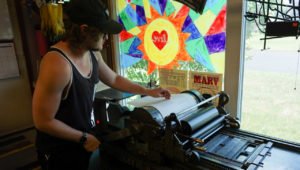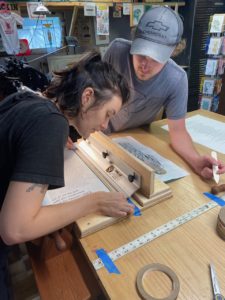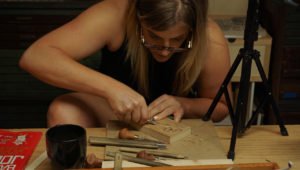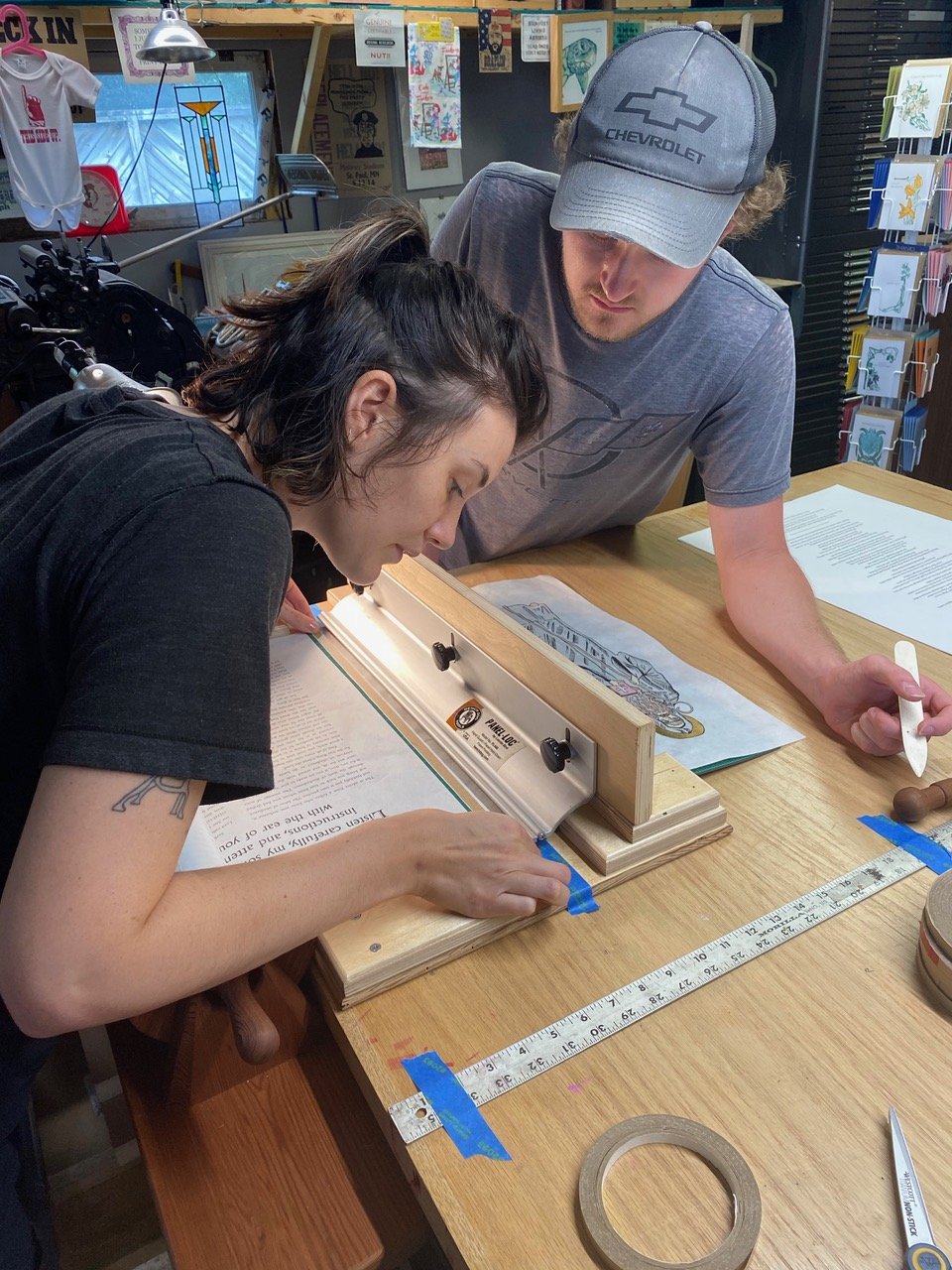by Tracy Rittmueller
news@thenewsleaders.com
For the past year St. Joseph-based artist-printer Mary Bruno, her apprentices Madeline Cochran, Scott Scribner, Lucian Eisenschenk and Ben Hamman, and St. John’s University artist-in-residence, potter Richard Bresnahan, have been collaborating with Sisters of St. Benedict’s monastery and other artisans to create a monumental work of art. On Aug. 11, they hermitically sealed Bresnahan’s large sculpture called “Kura Prophetic Messenger” to preserve its contents for, as Bruno said, “the next hundred million years.”
A “kura” is a Japanese earthen structure for storing valuables. Bresnahan’s Kura is a complex sculpture containing seeds native to Minnesota, stored in decorated clay pots, along with Bruno’s contemporary rendition of an ancient manuscript in an ancient form, “The Rule of Saint Benedict.” The value of these stored items lies in the symbolic message of its contents, which is, according to Bruno’s interpretation of Bresnahan’s artistic vision, that “God’s divine knowledge and peace [is capable of] saving us from war and destruction . . .[but] we never receive his message because of human imperfection.” The Bresnahan Kura sculpture is being installed at St. John’s University in Collegeville and was collaboratively designed by Bresnahan with advice from the monks of St. John’s Abbey.
The scroll of “The Rule of Saint Benedict” represents God’s divine knowledge about how humans can live in peace. The Rule is a document that has structured the communal lives of nuns and monks of the Order of St. Benedict (OSB) for almost 1,500 years. Joan Chittister, OSB, in her commentary on the Rule says that it is concerned with “what [life’s] about, what it demands, and how to live it. It has not failed a single generation.”
That we have been given a message that will save us from destruction, but that we never receive the message, is a grim thought. And yet the very existence of the artwork that issues this dire warning is a celebration of hope for human survival. The production of the project and in particular of this contemporary scroll of the Rule demonstrates that people are capable of setting aside seemingly radical differences and working together to create something beautiful, meaningful and life-nurturing.
To create the scroll to seal in the kura, Bresnahan chose local artist Bruno. She is an outspoken, free-spirited printer whose website proudly displays humorous, handcrafted cards and prints. For examples, there’s a poop emoji on one card, and some of her prints use the F-word.
Bruno collaborated with two past prioresses of St. Benedict’s Monastery (Katherine Howard and Michaela Hedican) who selected quotes from the “Rule of Benedict” for Bruno to highlight in her text. The monastery’s archivist, Mariterese Woida, OSB, and her staff provided images from the sisters’ 160-plus years in Central Minnesota.
There might have been conflicts. Some people can’t get past their superficial differences, such as word and clothing choices, or political and religious affiliations. These women hardly noticed the things that often break up relationships and families and instead built mutual respect based on their shared values.
“I admire and have always admired the Benedictine nuns,” Bruno said. “They’re badasses. They don’t shy away from hard work. They live humbly and try to be good community members. And I can relate to that.”
About Bruno’s and Bresnahan’s “lively interest in the ‘Rule of Saint Benedict,’” Sister Katherine said this: “Their enthusiasm for this project is inspiring in itself . . . There were some good laughs and many moments of nostalgia! We feel grateful for being a part of the rich, multi-faceted, down-to-earth life in central Minnesota. This beautiful, creative memorial is a wonderful tribute honoring the legacy of Benedictine men and women here.”
Sister Michaela expressed gratitude for the collaboration, saying, “It reminded me once again of the precious heritage we hold as Benedictines, how it has formed my life.”
About the process of working with Sister Katherine to present the Rule’s core wisdom to Bruno and Bresnahan, she said, “It was a delight to see how well-woven the Rule is, how Benedict was able to pull together the best of human nature, understanding how it had to be gently attended to, and yet setting it up so people have something to reach for. Our heritage is wonderful.”
Respect for heritage, finding the value in what is old and making it meaningful for the present is important to Bruno, too.
“Letterpress printing is old technology,” she said, “but I put my own modern spin on it, my own take on the imagery, the type and format, but it’s created in the way things have been created for hundreds of years. I’m using old-school vintage technology to make something that’s relevant today.”
“Being a cog in this wheel has given me a sense of purpose that I have not felt in a long while,” Bruno said. “I am grateful, I am honored, I am better at my craft, I am a more comprehensive creator . . . I’m not the most religious person but this was a kind of a religious experience.”
And the title of the work, “Kura Prophetic Messenger,” seems to be asking one of religion’s ongoing questions: Will we get the hopeful message of hope, that we are capable of living and working together in order to make life peaceful before we allow our human foibles to ruin us?
For an appointment to view one of the six hand-painted, hand-gilded copies of the letterpress printed scroll of the “Rule of Benedict,” which is also sealed in Bresnahan’s “Kura Prophetic Messenger” sculpture, contact Mary Bruno, Bruno Press, 154 Fifth Ave. SE., St. Joseph, or call 612-327-2542.








